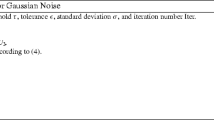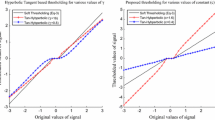Abstract
Reconstructing magnetic resonance images from undersampled k-space data is a challenging problem. This paper introduces a novel method of image reconstruction from undersampled k-space data based on the concept of singularizing operators and a novel singular k-space model. Exploring the sparsity of an image in the k-space, the singular k-space model (SKM) is proposed in terms of the k-space functions of a singularizing operator. The singularizing operator is constructed by combining basic difference operators. An algorithm is developed to reliably estimate the model parameters from undersampled k-space data. The estimated parameters are then used to recover the missing k-space data through the model, subsequently achieving high-quality reconstruction of the image using inverse Fourier transform. Experiments on physical phantom and real brain MR images have shown that the proposed SKM method constantly outperforms the popular total variation (TV) and the classical zero-filling (ZF) methods regardless of the undersampling rates, the noise levels, and the image structures. For the same objective quality of the reconstructed images, the proposed method requires much less k-space data than the TV method. The SKM method is an effective method for fast MRI reconstruction from the undersampled k-space data.

Two Real Images and their sparsified images by singularizing operator











Similar content being viewed by others
Notes
The codes used for the validation of proposed method can be asked by email to the authors.
References
Hasse A et al (1986) FLASH imaging, rapid NMR imaging using low flip-angle pulse. J Magn Reson 67:258–266
Untenberger, Markus, Zhengguo Tan, Dirk Voit, Arun A. Joseph, Volkert Roeloffs, K. Dietmar Merboldt, Sebastian Schätz, and Jens Frahm (2015) Advances in real- time phase- contrast flow MRI using asymmetric radial gradient echoes. Magn Reson Med
Griswold MA, Jakob PM, Heidemann RM, Nittka M, Jellus V, Wang J, Kiefer B, Haase A (2002) Generalized autocalibrating partially parallel acquisitions (GRAPPA). Magn Reson Med 47(6):1202–1210. https://doi.org/10.1002/mrm.10171
Sayin O, Haris S, Muz Zviman M, Griswold M, Halperin H, Seiberlich N, Herzka DA (2017) Real- time free-breathing cardiac imaging with self- calibrated through- time radial GRAPPA. Magn Reson Med 77(1):250–264. https://doi.org/10.1002/mrm.26112
Wright KL, Hamilton JI, Griswold MA, Gulani V, Seiberlich N (2014) Non-Cartesian parallel imaging reconstruction. J Magn Reson Imaging 40(5):1022–1040. https://doi.org/10.1002/jmri.24521
Tsao J, Boesiger P, Pruessmann KP. k-t BLAST and k-t SENSE: dynamic MRI with high frame rate exploiting spatiotemporal correlations. Magn Reson Med, 50 :1031–1042, 2003, 5, DOI: https://doi.org/10.1002/mrm.10611
Binter C, Ramb R, Jung B, Kozerke S (2016) A g-factor metric for k-t SENSE and k-t PCA based parallel imaging. Magn Reson Med 75(2):562–571. https://doi.org/10.1002/mrm.25606
D. L. Donoho (2006) “Compressed sensing,” IEEE Trans on Information Theory, 52(4):1289–1306
Candes EJ, Romberg JK, Tao T. Stable signal recovery from incomplete and inaccurate measurements. Commun Pur Appl Math, 59:1207–1223, 2006
Lustig M, Donoho DL, Santos JM, & Pauly JM (2008) “Compressed Sensing MRI,” IEEE Signal Processing Magazine, 25: 72–82
Lustig M, Donoho D, Pauly JM (2007) Sparse MRI: the application of compressed sensing for rapid MR imaging. Magn Reson Med 58(6):1182–1195. https://doi.org/10.1002/mrm.21391
Hatay GH, Yildirim M, Ozturk-Isik E (2017) Considerations in applying compressed sensing to in vivo phosphorus MR spectroscopic imaging of human brain at 3T. Med Biol Eng Comput 55(8):1303–1315. https://doi.org/10.1007/s11517-016-1591-9
Block K, Uecker M, Frahm J (2007) Undersampled radial MRI with multiple coils. Iterative image reconstruction using a total variation constraint. Magn Reson Med 57(6):1086–1098. https://doi.org/10.1002/mrm.21236
Chang CH, Yu X, Ji JX (2017, in press) Compressed sensing MRI reconstruction from 3D multichannel data using GPUs. Magn Reson Med 78(6):2265–2274. https://doi.org/10.1002/mrm.26636
Ravishankar S, Bresler Y (2011) MR image reconstruction from highly undersampled k-space data by dictionary learning. IEEE Trans Med Imaging 3(5):1028–1041
Li J, Song Y, Zhu Z, Zhao J (2017) Highly undersampled MR image reconstruction using an improved dual-dictionary learning method with self-adaptive dictionaries. Med Biol Eng Comput 55(5):807–822. https://doi.org/10.1007/s11517-016-1556-z
Qu X, Hou Y, Lam F, Guo D, Zhong J, Chen Z (2014) Magnetic resonance image reconstruction from undersampled measurements using a patch-based nonlocal operator. Med Image Anal 18(6):843–856. https://doi.org/10.1016/j.media.2013.09.007
Zhang Y, Yang J, Yang J, Liu A, Sun P (2016) A novel compressed sensing method for magnetic resonance imaging: exponential wavelet iterative shrinkage-thresholding algorithm with random shift. Int J Biomed Imaging 2016:1–10. https://doi.org/10.1155/2016/9416435
Lai Z, Qu X, Liu Y, Guo D, Ye J, Zhan Z, Chen Z (2016) Image reconstruction of compressed sensing MRI using graph-based redundant wavelet transform. Med Image Anal 93-104
Yang B, Yuan M, Ma Y, Zhang J, Zhan K (2015) Local sparsity enhanced compressed sensing magnetic resonance imaging in uniform discrete curvelet domain. BMC Med Imaging 15(1):28. https://doi.org/10.1186/s12880-015-0065-0
Sidky EY, Pan X (2008) Image reconstruction in circular cone-beam computed tomography by constrained, total-variation minimization. Phys Med Biol 53(17):4777–4807. https://doi.org/10.1088/0031-9155/53/17/021
Yin XX, Ng BH, Ramamohanarao K, Baghai-Wadji A, Abbott D (2012) Exploiting sparsity and low-rank structure for the recovery of multi-slice breast MRIs with reduced sampling error. Med Biol Eng Comput 50(9):991–1000. https://doi.org/10.1007/s11517-012-0920-x
Lin XX, Xia LY, Liang Y, Huang HH, Chai H. and Chan KF, (2016) Low-rank and sparse matrix decomposition based on S 1/2 and L 1/2 regularizations in dynamic MRI. In Image Processing Theory Tools and Applications (IPTA), 2016 6th International Conference on (pp. 1-6). IEEE
Xu F, Han J, Wang Y, Chen M, Chen Y, He G, Hu Y (2017) Dynamic magnetic resonance imaging via nonconvex low-rank matrix approximation. IEEE Access 5:1958–1966. https://doi.org/10.1109/ACCESS.2017.2657645
Liu Q, Wang S, Liang D (2017) Sparse and dense hybrid representation via subspace modeling for dynamic MRI. Comput Med Imaging Graph 56:24–37. https://doi.org/10.1016/j.compmedimag.2017.01.007
Wang S, Liu J, Liu Q, Ying L, Liu X, Zheng H, Liang D (2016) Iterative feature refinement for accurate undersampled MR image reconstruction. Phys Med Biol 61(9):3291–3316. https://doi.org/10.1088/0031-9155/61/9/3291
Kojima S, Shinohara H, Hashimoto T, Hirata M, Ueno E (2015) Iterative image reconstruction that includes a total variation regularization for radial MRI. Radiol Phys Technol 8(2):295–304. https://doi.org/10.1007/s12194-015-0320-7
Chartrand R Exact reconstruction of sparse signals via nonconvex minimization. IEEE Signal Processing Letters 14(10):707–710.2007
Kaleem M, Qureshi M, Omer H (2016) An adaptive algorithm for compressively sampled MR image reconstruction using projections onto l_ {p}-Ball. Appl Magn Reson 47(4):415–428. https://doi.org/10.1007/s00723-016-0761-0
Ramos-Llorden G, den Dekker AJ, Sijbers J (2017) Partial discreteness: a novel prior for magnetic resonance image reconstruction. IEEE Trans Med Imaging 36(5):1041–1053. https://doi.org/10.1109/TMI.2016.2645122
Luo JH, Zhu YM, Magnin I (2008) Phase correction-based singularity function analysis for partial K-space reconstruction. Magn Reson Imaging 26(6):746–753. https://doi.org/10.1016/j.mri.2008.01.035
Luo J, Zhu Y, Li W, Croisille P, Magnin IE (2012) MRI reconstruction from 2D truncated k- space. J Magn Reson Imaging 35(5):1196–1120. https://doi.org/10.1002/jmri.23538
Noll DC (1997) “Multishot rosette trajectories for spectrally selective MR imaging,” IEEE Trans. Medical Imaging 16(4):372–377. https://doi.org/10.1109/42.611345
Schirda CV, Tanase C, Boada FE (2009) Rosette spectroscopic imaging: optimal parameters for alias-free, high sensitivity spectroscopic imaging. J Magn Reson Imaging 29(6):1375–1385. https://doi.org/10.1002/jmri.21760
Moriguchi H, Duerk JL (2004) Iterative next-neighbor regridding (INNG): improved reconstruction from nonuniformly sampled K-space data using rescaled matrices. Magn Reson Med 51(2):343–352. https://doi.org/10.1002/mrm.10692
Funding
This work was supported in part by China Aviation Industry under the project (No. cxy204SHJD22, 2015), the National Natural Science Foundation of China (61271320 and 60872102), Medical Engineering Cross Fund of Shanghai Jiao Tong University (YG2014MS29), the Region Auvergne-Rhône-Alpes of France under the project CMIRA COOPERA/EXPLORA PRO 2016 and the 2010 UIC International Linkage Grant of University of Wollongong, Australia.
Author information
Authors and Affiliations
Corresponding author
Appendix: The implemented TV Algorithm
Appendix: The implemented TV Algorithm
The TV method is detailed as follows:
Input: | Undersampled k-space data G z (k i , k j ). |
|---|---|
TV | Find \( g=\arg \underset{g}{\min }{\sum}_{i=1}^N{\sum}_{j=1}^N\left|\nabla g\left(i,j\right)\right| \), s.t. ℱ[g(i, j)]H(k i , k j ) = G z (k i , k j ), where ∇ designates the gradient operator, H(k i , k j ) is the scanning matrix. |
Step 1 | Initialize the image to be reconstructed as g 0(i, j) = ℱ−1[G z (k i , k j )] and ϵ = ‖g 0(i, j)‖2 |
Step 2 | Reconstruction loop: for r = 1 to N r \( {g}_r^0\left(i,j\right)= real\left({g}^0\left(i,j\right)\right),\kern0.5em {g}_i^0\left(i,j\right)= imaginary\left({g}^0\left(i,j\right)\right), \) where g r (i, j) and g i (i, j) are the real and imaginary images of g(i, j) a) Perform TV gradient descent on the real and imaginary images independently: for t = 1 to N t \( {g}_r^t\left(i,j\right)={g}_r^{t-1}\left(i,j\right)-\alpha \in \nabla \left[\left|\nabla {g}_r^{t-1}\left(i,j\right)\right|\right] \) \( {g}_i^t\left(i,j\right)={g}_i^{t-1}\left(i,j\right)-\alpha \epsilon \nabla \left[\left|\nabla {g}_i^{t-1}\left(i,j\right)\right|\ \right] \) b) Apply consistency to the sampled k-space data and evaluate the change ϵ of the reconstructed image \( {G}^0\left({k}_i,{k}_j\right)=\left\{\begin{array}{ll}F\left[{g}^{N_t}\left(i,j\right)\right],& H\left({k}_i,{k}_i\right)=0\\ {}{G}_z\left({k}_i\cdot {k}_j\right),& H\left({k}_i,{k}_j\right)=1\end{array}\right. \) \( {g}^0\left(i,j\right)={\mathcal{F}}^{-1}\left[{G}^r\left({k}_i,{k}_j\right)\right] \) \( \epsilon =\left\Vert {g}^0\left(i,j\right)-{g}^{N_t}\left(i,j\right)\right\Vert \) c) if ϵ < 10−8, continue the r-loop. |
Step 3 | Output the reconstructed image g(i, j) = g 0(i, j) |
In the above TV method, Nr is the maximum number of iterations for the reconstruction of the image. It is empirically determined and set to 100 in the present study, beyond which there is no appreciable change in the image. Nt is the total number of gradient descent steps and is chosen as 20. α is a controlling parameter and is set to 0.08.
Rights and permissions
About this article
Cite this article
Luo, J., Mou, Z., Qin, B. et al. A singular K-space model for fast reconstruction of magnetic resonance images from undersampled data. Med Biol Eng Comput 56, 1211–1225 (2018). https://doi.org/10.1007/s11517-017-1763-2
Received:
Accepted:
Published:
Issue Date:
DOI: https://doi.org/10.1007/s11517-017-1763-2




